Tent is a portable shelter that many campers use for protection against the weather and insects. Most tents consist of an aluminum, carbon fiber, fiberglass, or steel frame with a covering and floor made of canvas, nylon, or polyester.
Tents are made in a variety of sizes and styles. They range from small models for one person to large cabin tents for as many as six adults. Extremely large tents are used for such activities as carnivals, circuses, and church meetings. This article discusses camping tents.

Kinds of tents.
There are over half a million styles and sizes of camping tents. Most of them are variations of one of six types: (1) A-frame (or ridge) tents, (2) dome tents, (3) tunnel tents, (4) geodesic tents, (5) pyramid tents, and (6) wall tents.

A-frame tents rise to a point at the top and resemble the letter A. One or two people can sleep in these small, lightweight tents, which are ideal for backpack trips. These tents are easy to pitch and relatively inexpensive but less commonly used than other types of tents.
Dome tents use two or three poles that arch over in a half circle and cross at the top of the tent. These tents are lightweight but provide ample space. Because of their shape, dome tents are stable and shed rain, snow, and wind well. Most of them are free-standing. Two to four people can sleep in them.
Tunnel tents use a series of curved parallel poles to create a tunnel. They are lightweight and offer maximum storage space but are not free-standing. Typically, they require more effort to pitch because guy lines are required. Guy lines are ropes or wires attached to something to steady or secure the tent. Tunnel tents are more affected by directional wind changes than other types of tents, so they may be less stable in strong winds.
Geodesic tents use crisscrossing poles that intersect over the surface, creating triangles. This structure evenly distributes weight throughout the tent. For this reason, geodesic tents are most frequently used in mountaineering.
Pyramid tents use a single central pole to prop up the middle of the roof. The walls fall away from the center and are staked to the ground. Pyramid tents are frequently floorless, which makes them portable and very light. One to four people can sleep in them. However, the more people inside the tent, the greater the risk of having someone kick over the center pole.
Wall tents resemble small houses. They have vertical walls and an A-frame roof. They provide more sleeping and standing room than A-frame tents but are harder to pitch. One kind of wall tent, the cabin tent, offers the highest degree of camping comfort. Its spacious interior and high walls allow more room for standing, walking, and sleeping than any other kind of tent. Wall tents are too large and heavy to carry in a backpack. They are used mainly by campers who drive to campsites.
Most tents of all kinds are made of canvas, nylon, or polyester. Canvas tents are bulky and heavy, but they naturally breathe well. A tent is said to breathe well when its fabric allows moisture to pass through without forming condensation on the interior surface and yet prevents water droplets from coming inside the tent. Canvas tents are used only for car camping. Both nylon and polyester tents are specially treated to prevent leakage. However, this treatment also seals moisture inside the tent and hinders the tent’s breathing. Most such tents have a roof with an untreated nylon layer through which moisture can pass, as well as a treated nylon covering, called a rain fly, which keeps rain out. Nylon and polyester tents are frequently used for backpacking.
All tents provide some type of ventilation and protection against rain and insects. Cabin tents have large windows and a door, and smaller tents have vents and a door flap. In most tents, these openings are covered with mesh that keeps insects out. Many tents have flaps to close over the windows during a storm. Some have a storm flap to put over the entire tent.
Pitching a tent.
Before setting up camp, campers should find a suitable spot to pitch their tent. The ideal campsite is at least 200 feet away from rivers or lakes so that camping activities do not contaminate the water. The site should also lie on high, level ground to help prevent the tent from being flooded during a storm. A tent should not be pitched close to trees with dead branches that could break off and strike the tent.
In most cases, the first step in pitching a tent is to spread out the floor and secure it to the ground with stakes. The stakes are driven into the ground through small loops along the bottom edge of the tent. The pitching procedure then varies according to the design of the tent. If the tent has an interior frame, the frame is erected and the fabric draped over it. A tent with an exterior frame has hangers to which the fabric is attached. The fabric should be stretched enough to eliminate large wrinkles, but not so tightly that it will rip.
Wall tents, tunnel tents, and some A-frame tents are staked with guy lines several feet from the tent. The guy lines are strung through holes along the top edges of the walls. Some A-frame tents have a guy line attached to the top of the tent at each end. Guy lines can be adjusted to assure the proper shape of the tent and tightness of the fabric.
Caring for a tent.
A tent properly cared for will last for years. It must be kept as clean and dry as possible. Insects and debris should be wiped off the tent each time it is taken down. If the tent is wet, it should be pitched and dried as soon as possible to avoid mildew and discoloration. After a camping trip, a tent should be cleaned and dried before storage. Tents can be washed with a nondetergent soap and a nonabrasive sponge. A washing machine or dryer should never be used. Poles and stakes should not be packed with the tent fabric because they could puncture it.
